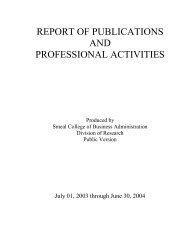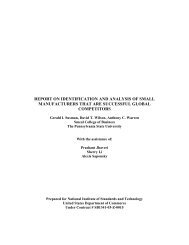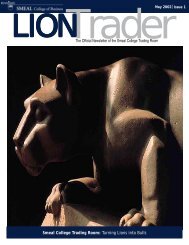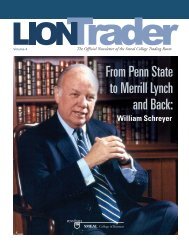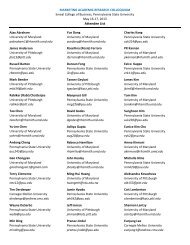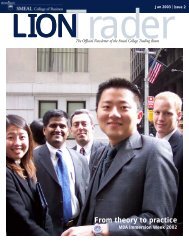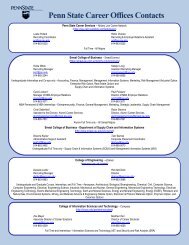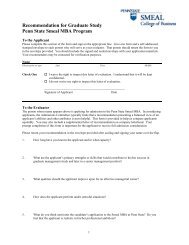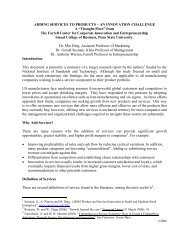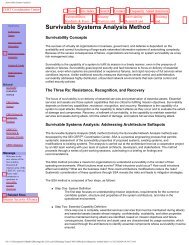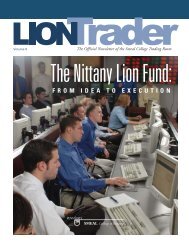Implementing Lean: From Concept to Results 58th Advanced ...
Implementing Lean: From Concept to Results 58th Advanced ...
Implementing Lean: From Concept to Results 58th Advanced ...
Create successful ePaper yourself
Turn your PDF publications into a flip-book with our unique Google optimized e-Paper software.
<strong>58th</strong> <strong>Advanced</strong> Manufacturing Forum<br />
Held on Oc<strong>to</strong>ber 21, 2005 at The Penn Stater Conference Center<br />
Sponsored by<br />
The Center for the Management of Technological and Organizational Change<br />
Gerald I. Susman, Direc<strong>to</strong>r<br />
<strong>Implementing</strong> <strong>Lean</strong>: <strong>From</strong> <strong>Concept</strong> <strong>to</strong> <strong>Results</strong><br />
David Adair<br />
Executive Vice President<br />
Absecon Mills<br />
Cologne, New Jersey<br />
David Adair admits that he is not a <strong>Lean</strong> expert. He is an executive vice president at Absecon<br />
Mills who was given the task of converting Absecon Mills in<strong>to</strong> a <strong>Lean</strong> enterprise three years ago.<br />
He says that it was both a great challenge and probably the most gratifying opportunity in his career.<br />
Quite <strong>to</strong> his surprise, <strong>Lean</strong> is something that he has become passionate about.<br />
Absecon Mills is a family-owned business that manufactures upholstery and is headquartered<br />
in Cologne, New Jersey. They are the largest provider of upholstery for theater seating. After<br />
many successful years of incredible growth, Absecon Mills had a period of crisis around 1996-97.<br />
Outside economic problems and an internal culture of inefficiency led <strong>to</strong> year-over-year declines for<br />
about five years. After searching for the best way <strong>to</strong> be competitive in the market, Absecon realized<br />
that it could compete with better quality, with shorter lead times and by implementing <strong>Lean</strong>.<br />
Coincidentally, one of Absecon Mill’s cus<strong>to</strong>mers conducted an audit of the Absecon facility.<br />
This cus<strong>to</strong>mer had used <strong>Lean</strong> for years and decided <strong>to</strong> reduce the number of their fabric suppliers<br />
from 20 <strong>to</strong> four. They had also decided that one of their suppliers would incorporate <strong>Lean</strong> in<strong>to</strong> its production.<br />
Leadership at Absecon Mills was excited about this prospect, and the cus<strong>to</strong>mer offered <strong>to</strong><br />
assist.<br />
A nine-person implementation team was assembled from all areas of the company and training<br />
began. Soon after, the cus<strong>to</strong>mer was ready <strong>to</strong> select the suppliers that it would retain. In making<br />
their final decision, they asked <strong>to</strong> speak with the senior leadership at Absecon Mills. Adair shared<br />
with them the three things that Absecon felt were necessary <strong>to</strong> implement <strong>Lean</strong> successfully:<br />
1) Commitment from management<br />
2) Commitment from management<br />
3) Commitment from management<br />
This was exactly what the cus<strong>to</strong>mer wanted <strong>to</strong> hear.<br />
Surprisingly, convincing inves<strong>to</strong>rs that <strong>Lean</strong> has value turned in<strong>to</strong> a challenge for Absecon.<br />
For example, the benefits of <strong>Lean</strong> were examined when Absecon Mills changed banks. Some of the<br />
questions were easy and were answered by showing the dollar value of such fac<strong>to</strong>rs as off-quality,<br />
inven<strong>to</strong>ry reduction, shortened lead times, and reductions in the cash-<strong>to</strong>-cash cycle. But the inves<strong>to</strong>rs<br />
did not understand why the labor force was not being reduced. Explaining that <strong>Lean</strong> does not seek<br />
<strong>to</strong> lay off workers but rather lets natural attrition do this over time was hard for them <strong>to</strong> understand.<br />
They also wondered how increased efficiency in production meant anything without an increase in<br />
sales. Making the cus<strong>to</strong>mer happy with increased quality and reduced lead times would increase
59th <strong>Advanced</strong> Manufacturing Forum<br />
Oc<strong>to</strong>ber 21, 2005<br />
<strong>Implementing</strong> <strong>Lean</strong>: <strong>From</strong> <strong>Concept</strong> <strong>to</strong> <strong>Results</strong>, by David Adair, page 2<br />
sales and profits, but it would take time.<br />
The intangibles of <strong>Lean</strong> are also huge positives that were hard <strong>to</strong> describe <strong>to</strong> inves<strong>to</strong>rs. It is<br />
difficult <strong>to</strong> put a value on increasing employee morale and creating inclusion, for example. But these<br />
are very valuable. Employees have input in<strong>to</strong> the process. They make things better. Feeling that<br />
they are part of the team provides employee satisfaction, more so than money.<br />
Absecon Mills has seen very tangible benefits from <strong>Lean</strong>: inven<strong>to</strong>ry of raw materials dropped<br />
36%, inven<strong>to</strong>ry of finished goods dropped 31%; lead time on the largest product line (which accounts<br />
for approximately 60% of the business) went from 28 <strong>to</strong> 18 days. Quality has improved. And the increase<br />
in production per worker by 26% has kept direct labor costs at the same level as they were in<br />
2000, even with pay increases.<br />
They still have a long way <strong>to</strong> go but Adair feels that a culture change coming. “Once the ball<br />
starts rolling it is powerful.” Improvements are being made not just through focused events but from<br />
individuals on their own. The pace is much greater. A state grant of $80,000 <strong>to</strong> implement <strong>Lean</strong> allowed<br />
Absecon <strong>to</strong> secure trainers that speak Spanish, thereby providing inclusion for their Spanishspeaking<br />
workforce.<br />
Adair ended with some closing thoughts on <strong>Lean</strong>:<br />
• Focus on the long term – grow leaders from inside the organization.<br />
• Make it a complete strategy throughout the company.<br />
• To really reduce lead time you must work the supply chain.<br />
• Keep yourself motivated – read books on <strong>Lean</strong> and leadership.<br />
• Focus on the people, not just the process.<br />
• And finally, let the little vic<strong>to</strong>ries sustain you!



